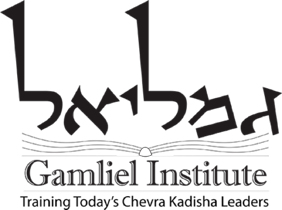Why Do Community Education?
What is Community Education?
The rich cycle of ritual events that honor the passage of time in our lives within the Jewish tradition treats death simply as one element of the cycle of life. (For a more in-depth look at this, see the Jewish Life Cycle page.) This cycle relates directly to engaging our community members in education about Jewish end-of-life traditions.
Just as we teach about bar and bat mitzvot, brit milah, and wedding traditions and rituals, so, too, must we teach our children, parents, and neighbors about how death is handled in the Jewish community, what the rituals and traditions are, and why they are important. Often, communities will include death education along with other life-cycle event classes. Children of all ages can be taught about death, about the Chevrah Kadisha (holy society), kavod hameit (honoring the dead), and nichum avelim (comforting mourners).
The work of the Chevrah Kadisha begins before death (visiting the sick, life review, ethical wills, funeral and burial planning), continues through the time of death (taharah, shmirah, kri’ah and burial), to the year after death (consoling mourners, meals of comfort, shiva, and grief processing), and beyond.
In some communities, elements of this continuum of caring may be already organized, such as synagogues with Bikkur Cholim committees or rabbis who play a coordinating role. In other communities, there is an opportunity for the Chevrah Kadisha to support others or to provide these services. Congregants’ search for spirituality and meaningful involvement is deepened by helping them bring the full range of these mitzvot back into their own hands. Today, in North America, more and more Jews are reclaiming mitzvot along the entire spectrum of life, personalizing them, and creating meaningful moments in their own lives.
The Richness of Jewish Death Traditions
Judaism is about life: the opportunity to do good, to create, to make the world a better place. Unlike many other religions, the Jewish focus is not on the afterlife: it is on olam hazeh, the here and now. When we focus on death, it is because death is a part of life, although a part that is often ignored or denied. Mortality is what we all have in common. How we deal with death, our attitudes, our practices, our institutions — these are the reflection of our approach to life.
Most of us form impressions about death from our own positive and negative experiences and from learning about the experiences of others. This experiential learning usually has no historical or intellectual grounding, and is circumscribed by our culture’s professionalization and compartmentalization of death practices. Fortunately, our learning about death does not need to conform to these restrictions.
The study of historical and contemporary Jewish writings about death can give us a life-enhancing complement to experiential learning. Our heritage offers us a rich and profound body of knowledge that includes basic source texts and commentary, guidelines for practice, all within a framework of psychological wisdom. Unfortunately, too few of us are acquainted with — or even aware of — this heritage.
Jewish traditions and rituals relating to death are based on respect: respect for the deceased as a person, respect for the soul of the deceased, respect for the body of the deceased as a holy vehicle of the soul, respect for the family of the deceased, respect for the cycle of life in which death is a part, and respect for the entire community. This principle of kavod hameit, honoring the dead through respect and ritual, underlies all aspects of our death practices. This same respect for human life permeates all of Jewish teachings.
We are considered b’tzelem Elohim, created in the image of the Divine. Hence we treat humans with great respect while they are alive, and also when they die. Our traditions honor the holiness that is in each of us. We are considerate of the dead, not leaving them alone from death until burial, to help comfort the soul during this liminal time.
Judaism has a special ritual through which Jews lovingly prepare a body for burial. This is profoundly different from the Westernized treatment of a “dead body”. The Jewish preparation ritual is called taharah, and includes a gentle and respectful cleaning of the body, followed by a spiritual purification using water, after which the body is carefully dressed in burial garments that represent the attire of the High Priest in the days of the Temple, who on Yom Kippur would enter the Holy of Holies to pray for the people. We are each dressed alike to go before G-d. This entire ritual is filled with beauty, gentleness, and respect, and is accompanied by a powerful liturgy taken from selected portions of the Tanach and woven into a Kabbalistic blanket through which we wrap our loved ones.
Jewish burial practices continues this respectful process by honoring both the family and the deceased through timely interment and community engagement. This is followed by community support and comfort of the grieving family as mourning begins, including a meal of consolation and prayer services at the family’s home.
Our mourning practices help us face our grief head on, and give us a structure through which we are guided back into life. At times the process may not flow smoothly, but the community helps us deal with loss in a compassionate and caring manner. The community supports and honors the grieving family, recognizing their path of healing, and enabling them to mourn fully while re-engaging in life and future.
Jewish death practice includes a rich collection of traditions and rituals that help us honor life and heal after loss. These practices are powerful, yet gentle, caring, and respectful. They remind us that all of life is holy and worthy of respect and dignity. They remind us how to live, so we must teach them as part of the cycle of life in our rich tradition.
Integrating Death into Life
Death denial is prevalent in today’s world. In the West it is almost impossible to get away from it. The American culture is especially focused on youthfulness: it ignores, demeans and disowns aging, dying, and death as realities that must be faced. Instead, our culture emphasizes restoring youth as we age: looking younger, feeling younger, dressing younger and acting younger. It’s no wonder that most people have no clue what to do as they age and when death arrives. Aging and death have been constantly pushed aside, put on the back burner, and denied a place in our awareness.
This was not always the case. Only in the last 100 years have many North American Jewish communities abandoned the full range of traditional Jewish practice. Before, death was very much a part of life. However, today, this abandonment stems from the Jewish community’s acceptance of Western culture’s avoidance and denial of death and its tendency to rely on specialists. This is coupled with the Jewish community’s lack of experience and education for adults and children about Jewish dying, death, and mourning traditions. These communal shortcomings evidence a lack of the crucial understanding that fosters an acceptance of responsibility to care for its members throughout their lives.
In response to this, in recent decades, there has been a movement to raise awareness, infuse conscious action, and increase education related to aging, dying, and death. For example, Rabbi Zalman Shachter-Shalomi, z”l, extended and expanded the work of Elizabeth Kubler-Ross, z”l, who opened the door on death awareness in mid-20th century America. Reb Zalman’s book, From Age-ing to Sage-ing, took a Jewish view of aging in which he helps us face and re-frame the question of how to continue living as we age. A second example is the work of Rabbi Richard Address in podcasts and radio shows that focus on healthy aging. Another example is Rabbi Dayle Friedman’s book Jewish Visons for Aging.
Judaism attempts to address issues relating to death by including specific death remembrances in every prayer service (Kaddish), four times each year (Yizkor), and on the anniversary of our loved ones’ deaths (Yahrzeit). When the Jewish Life Cycle is taught, death is taught as a “normal” expected part of the cycle.
Judaism teaches us to accept death as a part of life, not deny and ignore it while hoping it will go away. Instead, our traditions guide us to face our own mortality, thereby enriching our living and our humanity. By facing death we honor not only our teachers, ancestors and parents who have died; we also honor the traditions they have preserved for us. And by owning our own mortality, we live more consciously, richly, and respectfully, and through this we set examples for our children as to how to live and die with grace and dignity.
By educating ourselves, our children, our neighbors, and our community about Jewish traditions, rituals, beliefs and benefits relating to death, we ensure that this awareness and appreciation of death continues, thus enriching our community, its members, and our lives.

